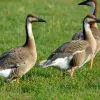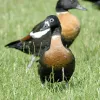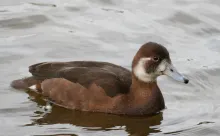
Southern pochard (Netta erythrophthalma brunnea)
Species name
- Dutch name:
- Zuiderse duikeend
- English name:
- Southern pochard
- German name:
- Rotaugenente
- French name:
- Nette brune
- Scientific name:
- Netta erythrophthalma brunnea
Scientific classification
- Order:
- Anseriformes
- Family:
- Anatidae
- Onderfamilie:
- Aythyinae
- Genus:
- Netta
Description
- Description:
Male:
Head and neck dark brown to blackish with purplish sheen , and with slight peak to rear of crown. Breast and entire under parts dark chestnut-brown, slightly richer chestnut on flanks. Upperparts dark olive- brown upper wing dark brown with broad white wing-band across seconderies and all but outmost primaries, which are brown, as are tips of to all flight feathers ; under wing lighter brown, with paler flight feathers. Bill Blue-grey with black nail. Legs and feet dark grey. Iris bright Red. conspicuous in flight. has no eclipse plumage.Female:
Forehead, crown and nape brownish black , becoming more umber-brown on cheeks ; white of chin and throat extends up to patch at base of bill and as ill- defined crescent curling up sides of head to just behind the eye. Under parts similar to male, but browner, with rusty coloring on flanks; and whitish mottling on the belly and vent extending to whitish under tail converts . Upper parts as male, but browner and vermiculated Buffy brown . Wing and tail as male. Bill duller grey then male. Iris brown .Juvenile:
resembles female, but top of head more brownish. Whitish eye-stripe less pronounced. Body coloration lighter brown.
Standard Measurements
- Body Length (cm):
- The male (drake) of the Southern pochard measures approximately 48-50 centimeters. The female measures approximately 48-50 centimeters.
- Body Weight (grams):
- The male will weight about 455-815 gram. The female will weight about 455-815 gram.
The weight is notoriously variable and can only be used as indication!
- Subspecies:
There is two subspecies:
- Netta erythrophthalma brunnea - Southern(African) Pochard
- Netta erythrophthalma erythrophthalma - Southern(South America) Pochard
- Note:
Nest is depression lined with grass, reed stems, down and some feathers, on ground or over water in thick vegetation.
- Breeding:
- The female Southern pochard usually lays from 6-15 Creamy white eggs and incubates them for 26-28 days.
- Artificial incubating:
The ideal relative humidity for incubating most waterfowl eggs is 55% (ground nesters) and 40% (cavity nesters). The temperature is usually 37.4°C. Set ventilation as recommended by the incubator manufacturer. Eggs must be turned, either automatically or by hand, a minimum of 4 times a day. As the duckling develops there is a loss of water from the egg and the air sac gets bigger. In normal development of an egg with a 26-28 days incubation, the air sac occupies about a third of it three days earlier. Cleanliness is vital and ideally eggs should be moved to a separate hatcher at this point, where the humidity should be increased to 65% and even higher once they have pipped internally.
- Bird banding:
- Recommended closed leg band ring size for the Southern pochard is 11 mm.The leg band ring can only be applied on a young duck at around 12-14 days old.
- It doesn't matter what leg that you band, but it's good to have a consistent system. Suggested: Left leg = Female, Right leg = Male
- Maintenance food:
-





Lundi Regular with a protein content of 20%, valuable Spirulina and high-quality by-products is optimally balanced in its composition maintenance food for water ornamental fowl of all kinds. Especially green teal and Whistling ducks that are not dependent on a very high protein content, are well supplied.
Lundi Regular contains all the minerals and vitamins in full form that are important for the animals. Therefore also suitable as breeding food.





Floating full food for all sea ducks, green ducks, eider ducks and geese, especially in the moulting and breeding phase ideally suited. Packed with wholesome raw materials, natural vitamins and trace elements, this performance food with a protein content of 30% forms the basis for lifelong vitality.
